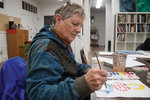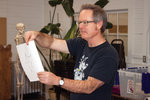Warm-up exercises are standard practice for professional athletes, but illustrator Dana Sullivan gets artists limbered-up, too, with warm-up sketches before class starts.
From Oct. 1 through Nov. …
This item is available in full to subscribers.
We have recently launched a new and improved website. To continue reading, you will need to either log into your subscriber account, or purchase a new subscription.
If you had an active account on our previous website, then you have an account here. Simply reset your password to regain access to your account.
If you did not have an account on our previous website, but are a current print subscriber, click here to set up your website account.
Otherwise, click here to view your options for subscribing.
* Having trouble? Call our circulation department at 360-385-2900, or email our support.
Please log in to continue |
|


Warm-up exercises are standard practice for professional athletes, but illustrator Dana Sullivan gets artists limbered-up, too, with warm-up sketches before class starts.
From Oct. 1 through Nov. 5, Sullivan taught six Tuesdays of “Illustrating Children’s Books” at the Port Townsend School of the Arts, and those who showed up before the class officially kicked off at 6 p.m., which was nearly everyone, were subjected to one-minute timed drills of sketch artistry.
“A frog flying,” Sullivan called out, as his students pounced on their sheets of paper with their pens. A minute later? “A skeleton dancing,” Sullivan barked, like a coach with a stop-watch. Every 60 seconds, the alarm on his smartphone would beep, and he’d call out the next prompt. “Two girls arguing.” “Ice skating.”
Sullivan believes speed and spontaneity are allies of the creative process.
“The goal is to get your ideas down on paper fast,” Sullivan said. “We all have great ideas that we censor when we think about them. Once you get it on paper, not only do you usually see it’s not so bad, but at least you have something to work with, even if it is bad, rather than something ephemeral that doesn’t actually exist.”
As Sullivan reviewed the illustrations his students had made, he praised them for “not getting bogged down in details,” and instead conveying character through line and form.
“These aren’t anatomically correct, but they sure do look like skeletons,” Sullivan said. “Look at this one, and how its gestures indicate its movements.”
Sullivan then tasked his students with each folding a sheet of paper into thirds, drawing a head on the first third, covering it over and passing it to the person to their left to draw arms and a torso, then covering that up, passing it to the left again, and drawing everything below the waist, all without seeing what the other artists had drawn.
When the students unfolded their sheets of paper, they were met with an assortment of collaboratively created hybrids, which they then water-colored.
“Mistakes are just cool,” Sullivan said. “As you look at these things you’ve come up with, ask yourselves, ‘What is its story?’ It’s one of the reasons a story can turn out better if a writer doesn’t give their illustrator notes, because the writer might say, ‘Oh, that’s not what I meant,’ but in the illustrator’s hands, it turns out better.”
When brainstorming for story ideas, Sullivan advocated shamelessly pilfering from well-known fairy tales, employing puns and plays on words, and writing a bit above what you think your young audience’s reading level might be.
“Don’t be afraid to go over kids’ heads,” Sullivan said. “They might not get the jokes right away, but they recognize the setup to a joke, and they will work to figure it out. I remember doing the same when I grew up, reading MAD Magazine.”
“There’s nothing better than humor that can appeal to both kids and adults,” said Hillary Verheggen, youth services manager for the Port Townsend Public Library, as she sat in on the class. “It has a real staying power if you can continue to appreciate it, just on a different level, as you grow up.”
Once class had begun in earnest, Sullivan evaluated the illustrated storybook drafts that his students had been working on for the past few weeks, starting with David Alan Moore’s picture book about a boy named “Corn Nut” who sneezed when his school picture was taken, so he swore to make sure his school picture was perfect the next time, only for him to lose one of his teeth right before the picture day.
Although Moore had storyboarded weeks before, a back injury had sidelined his production, and his final illustrations had flowed out of him earlier that afternoon, “under the influence” of painkillers.
Sullivan gushed over Moore’s drawings, and joked that he should injure his back more often.
Lara Gaasland-Tatro produced “S is for Schooner: A Nautical Alphabet,” which Sullivan complimented for its “strong, clean rhymes,” which he noted she’d developed over time.
Just as Sullivan had asked his students to consider how much text they could take away from a page, so as not to duplicate information already provided by the picture, so too did he urge them to consider the perspective of parents who will be reading those books to their children.
“They’re going to be reading the same words over and over and over, so you shouldn’t give them too many,” Sullivan said. “The pictures should give them plenty to talk about, without having so many elements that they go gray if you squint at them.”
Sullivan’s focus on simplicity is one of the factors that made Teresa Verraes, executive director of the Port Townsend School of the Arts, consider him an ideal candidate to teach a class there.
“He was a volunteer at one of our summer fundraisers, wearing a T-shirt with one of his characters on it,” Verraes said of Sullivan, the creator of “Dead Max Comix,” which launches in January of 2020. “He was energetic and demonstrated this really broad skill base, but what’s been great is that he believes you can bring out the artist in everyone, and he makes them believe it, too.”
Verraes noted that the mere prospect of enrolling in art classes can be intimidating for many people, but she credited Sullivan with bolstering his students’ confidence by encouraging them to have a sense of humor about their work.
“People will say, ‘Oh, I can’t even draw a stick figure,’ but that’s literally not true,” Verraes said. “I’ve loved watching Sullivan’s students transform over these six weeks, as they go from a place of uncertainty to recognizing how much creativity they have in their hearts.”
FROM CORPORATE MARKETING TO KIDS’ BOOKS
Sullivan recalls drawing on his math worksheets in school, reading comics and aspiring to be the next Maurice Sendak, but it was around fifth grade that he started to realize he had some actual talent.
Drawing for his junior high yearbook, and then for his high school paper, led Sullivan to take art courses in college, where he got degrees in comparative literature and graphic design.
“I ended up working for Costco Wholesale as the creative director in the marketing department,” Sullivan said. “I designed that logo! I worked there for 16 years, but eventually needed to be more creative, so I quit and started taking classes in children’s book writing and illustrating.”
After a couple of years, Sullivan landed an agent, who sold his first book, “Ozzie and the Art Contest,” in 2013.
Sullivan has been working in illustration professionally for 30 years, including his design work, and in picture books for 10 years. He’s also been teaching picture book illustration in the Seattle area for seven years, and his next course at the Port Townsend School of the Arts is tentatively set for this coming spring.
Sullivan did a lunchtime comics session at Port Townsend High School, and has two more sessions slated for Nov. 25 at Blue Heron Middle School, in partnership with Verheggen and Port Townsend Schools Librarian Joy Wentzel.
School visits are the best,” Sullivan said. “I love to visit schools and get the kids excited about writing and drawing. Those kindergartners treat you like a rock star, even if they’ve never heard of you.”
Part of the reason why Sullivan pushes his students to produce “messy first drafts” as fast as they can is because the publishing process is so laborious.
“You’ve got to drive through mediocre if you’re gonna get to great, and there’s no bypass or shortcut,” Sullivan said. “Once you’ve made a book dummy, which is the combination of your pencil sketches and the text, you’ll wish you were done, but that’s only your first draft. Once that is the best you can make it, you submit to publishers, and then there are going to be rejections. You tell yourself each rejection is one step closer to publication, but man, does it hurt.”
Sullivan recalled that “Ozzie and the Art Contest” was rejected 26 times, and “Dead Max Comix” was rejected 77 times.
“There’s not a lot of money in picture books, so you’ve really got to love doing it,” Sullivan said. “It’s a ton of work, but a ton of fun work.”
“Dead Max Comix” is Sullivan’s first graphic novel, and it’s launching at the Port Townsend School of the Arts Grover Gallery on Jan. 23, 2020.
“It’s a four-book series, and I’m working on book three now,” Sullivan said. “Like all my books, there’s a lot of me in this story. I was pretty shy as a kid, and I had a dog named Max, who is now in an urn on my shelf. I really could have used a ghost dog, to help me out with school, friends, family, and the feeling that I was the only weirdo in the world.”